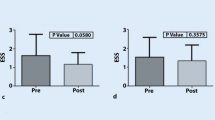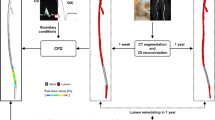Abstract
Background Wall shear stress (WSS) has been associated with neointimal hyperplasia (NIH) following bare metal stent (BMS) implantation. Drug-eluting stents (DES) almost abolish NIH. Conversely, diabetes mellitus amplifies NIH response. The association between WSS and arterial wall response following DES and BMS implantation in diabetic patients remains to be evaluated. Methods The study involved 20 diabetic patients randomized to BMS (n = 9) or sirolimus-eluting stent (SES; n = 11) implantation in native coronary arteries. A computational fluid dynamic model applied 3D intravascular ultrasound (IVUS) and two-plane angiographic to measure WSS (Pa). IVUS assessments were performed post-procedure and at 9-months follow-up. The target segment encompassed the stent plus 5 mm distal and proximal edges. A total of 93 subsegments were evaluated: in-stent segments divided in three subsegments (proximal, mid and distal; n = 60) and proximal and distal edges (n = 33). Results Stent length was similar between BMS (17.4 ± 7.3 mm) and SES (19.8 ± 6.8 mm) groups. NIH was observed in all BMS subsegments (n = 27) versus one subsegment in the SES group (n = 33). WSS ranged from 0.52 to 4.20 Pa in the BMS and from 0.42 to 3.06 Pa in the SES group. There was no correlation between WSS and NIH in either stent group. In addition, there were no correlation between the change of external elastic membrane (EEM) or plaque growth at the edges and WSS. Conclusion WSS was not associated with NIH after implantation of SES or BMS in diabetic patients. Plaque growth or the change of EEM at the edges were not associated with WSS either.




Similar content being viewed by others
Abbreviations
- NIH:
-
Neointimal hyperplasia
- WSS:
-
Wall shear stress
- CFD:
-
Computational flow dynamics
- 3D:
-
Three-dimensional
- BMS:
-
Bare metal stent
- SES:
-
Sirolimus-eluting stent
- DM:
-
Diabetes mellitus
- DIABETES:
-
The Diabetes and Sirolimus-Eluting Stent Trial
- IVUS:
-
Intravascular ultrasound
- QCA:
-
Quantitative coronary analysis
- ΔEEM:
-
Change in external elastic membrane
- DES:
-
Drug-eluting stent
- RCA:
-
Right coronary artery
- LAD:
-
Left anterior descending coronary artery
- LCX:
-
Left circumflex coronary artery
References
Costa MA, Simon DI (2005) Molecular basis of restenosis and drug-eluting stents. Circulation 111(17):2257–2273
Glagov S, Vito R, Giddens DP, Zarins CK (1992) Micro-architecture and composition of artery walls: relationship to location, diameter and the distribution of mechanical stress. J Hypertens Suppl 10(6):S101–S104
Glagov S (1994) Intimal hyperplasia, vascular modeling, and the restenosis problem. Circulation 89(6):2888–2891
Krams R, Wentzel JJ, Oomen JA, Vinke R, Schuurbiers JC, de Feyter PJ et al (1997) Evaluation of endothelial shear stress and 3D geometry as factors determining the development of atherosclerosis and remodeling in human coronary arteries in vivo. Combining 3D reconstruction from angiography and IVUS (ANGUS) with computational fluid dynamics. Arterioscler Thromb Vasc Biol 17(10):2061–2065
Wentzel JJ, Krams R, Schuurbiers JC, Oomen JA, Kloet J, van Der Giessen WJ et al (2001) Relationship between neointimal thickness and shear stress after Wallstent implantation in human coronary arteries. Circulation 103(13):1740–1750
Marx SO, Jayaraman T, Go LO, Marks AR (1995) Rapamycin-FKBP inhibits cell cycle regulators of proliferation in vascular smooth muscle cells. Circ Res 76(3):412–417
Abizaid A, Costa MA, Blanchard D, Albertal M, Eltchaninoff H, Guagliumi G et al (2004) Sirolimus-eluting stents inhibit neointimal hyperplasia in diabetic patients. Insights from the RAVEL Trial. Eur Heart J 25(2):107–112
Sabate M, Jimenez-Quevedo P, Angiolillo DJ, Gomez-Hospital JA, Alfonso F, Hernandez-Antolin R et al (2005) Randomized comparison of sirolimus-eluting stent versus standard stent for percutaneous coronary revascularization in diabetic patients: the diabetes and sirolimus-eluting stent (DIABETES) trial. Circulation 112(14):2175–2183
Gijsen FJ, Oortman RM, Wentzel JJ, Schuurbiers JC, Tanabe K, Degertekin M et al (2003) Usefulness of shear stress pattern in predicting neointima distribution in sirolimus-eluting stents in coronary arteries. Am J Cardiol 92(11):1325–1328
Moussa I, Leon MB, Baim DS, O’Neill WW, Popma JJ, Buchbinder M et al (2004) Impact of sirolimus-eluting stents on outcome in diabetic patients: a SIRIUS (SIRolImUS-coated Bx Velocity balloon-expandable stent in the treatment of patients with de novo coronary artery lesions) substudy. Circulation 109(19):2273–2278
Jimenez-Quevedo P, Sabate M, Angiolillo DJ, Costa MA, Alfonso F, Gomez-Hospital JA et al (2006) Vascular effects of sirolimus-eluting versus bare-metal stents in diabetic patients: three-dimensional ultrasound results of the Diabetes and Sirolimus-Eluting Stent (DIABETES) Trial. J Am Coll Cardiol 47(11):2172–2179
Kawaguchi R, Sabate M, Angiolillo DJ, Jimenez-Quevedo P, Suzuki N, Corros C et al (2007) Angiographic and 3D intravascular ultrasound assessment of overlapping bare metal stent and three different formulations of drug-eluting stents in patients with diabetes mellitus. Int J Cardiovasc Imaging (in press)
Slager CJ, Wentzel JJ, Schuurbiers JC, Oomen JA, Kloet J, Krams R et al (2000) True 3-dimensional reconstruction of coronary arteries in patients by fusion of angiography and IVUS (ANGUS) and its quantitative validation. Circulation 102(5):511–516
Schuurbiers JC, von Birgelen C, Wentzel JJ, Bom N, Serruys PW, de Feyter PJ et al (2000) On the IVUS plaque volume error in coronary arteries when neglecting curvature. Ultrasound Med Biol 26(9):1403–1411
Moore JE Jr, Xu C, Glagov S, Zarins CK, Ku DN (1994) Fluid wall shear stress measurements in a model of the human abdominal aorta: oscillatory behavior and relationship to atherosclerosis. Atherosclerosis 110(2):225–240
Aronson D, Bloomgarden Z, Rayfield EJ (1996) Potential mechanisms promoting restenosis in diabetic patients. J Am Coll Cardiol 27(3):528–535
Indolfi C, Torella D, Cavuto L, Davalli AM, Coppola C, Esposito G et al (2001) Effects of balloon injury on neointimal hyperplasia in streptozotocin-induced diabetes and in hyperinsulinemic nondiabetic pancreatic islet-transplanted rats. Circulation 103(24):2980–2986
Stone KE, Chiquette E, Chilton RJ (2007) Diabetic endovascular disease: role of coronary artery revascularization. Am J Cardiol 99(4A):105B–112B
Angiolillo DJ, Shoemaker SB, Desai B, Yuan H, Charlton RK, Bernardo E et al (2007) Randomized comparison of a high clopidogrel maintenance dose in patients with diabetes mellitus and coronary artery disease: results of the optimizing antiplatelet therapy in diabetes mellitus (OPTIMUS) study. Circulation 115(6):708–716
Moses JW, Leon MB, Popma JJ, Fitzgerald PJ, Holmes DR, O’Shaughnessy C et al (2003) Sirolimus-eluting stents versus standard stents in patients with stenosis in a native coronary artery. N Engl J Med 349(14):1315–1323
Lasave LI, Abizaid AA, de Ribamar Costa J, Jr. Tanajura LF, Feres F, Abizaid AS, et al (2007) Late vascular response at the edges of sirolimus analogous-eluting stents in diabetic patients: an intravascular ultrasound study. Catheter Cardiovasc Interv 70(4):498–503
Brownlee M (2001) Biochemistry and molecular cell biology of diabetic complications. Nature 414(6865):813–820
Author information
Authors and Affiliations
Corresponding author
Additional information
N. Suzuki and H. Nanda contributed equally to this manuscript.
Rights and permissions
About this article
Cite this article
Suzuki, N., Nanda, H., Angiolillo, D.J. et al. Assessment of potential relationship between wall shear stress and arterial wall response after bare metal stent and sirolimus-eluting stent implantation in patients with diabetes mellitus. Int J Cardiovasc Imaging 24, 357–364 (2008). https://doi.org/10.1007/s10554-007-9274-0
Received:
Accepted:
Published:
Issue Date:
DOI: https://doi.org/10.1007/s10554-007-9274-0




